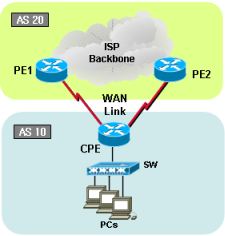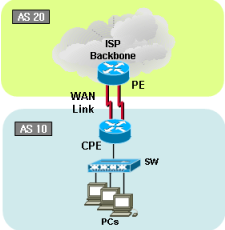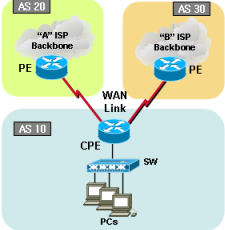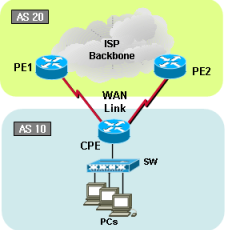
Cisco dual BGP with Metric (Redundancy)
|
|
[Traffic flow]
[CPE/Customer Cisco Router]
Current configuration:
!
version 12.x
!
hostname CPE
!
interface Ethernet0
description to Internal network
ip address 10.1.0.1 255.255.255.0ip address 10.1.0.129 255.255.255.128 secondaryno ip directed-broadcast
no ip mroute-cache
!
interface Serial0
description to ISP A – WAN 1
ip address 12.1.3.1 255.255.255.252
no ip directed-broadcast
no ip mroute-cache
no fair-queue
!
interface Serial1
description to ISP A – WAN 2ip address 12.1.4.1 255.255.255.252
no ip directed-broadcast
no ip mroute-cache
no fair-queue
!
router bgp 10
no auto-summarynetwork 10.1.0.0 mask 255.255.255.0neighbor 12.1.3.2 remote-as 20
neighbor 12.1.3.2 version 4
neighbor 12.1.4.2 remote-as 20
neighbor 12.1.4.2 version 4neighbor 12.1.4.2 prefix-list 1 out
neighbor 12.1.4.2 route-map shadow_inbound inneighbor 12.1.4.2 route-map shadow_outbound out!
ip classless
!ip prefix-list 1 seq 5 permit 10.1.0.0/24 le 32
!
route-map shadow_inbound permit 10
set local-preference 80
!
route-map shadow_outbound permit 10
set metric 200
!
!
line con 0
line aux 0
line vty 0 4
login
!
end
[PE1 / ISP Cisco Router]
Current configuration:
!
version 12.x
!
hostname PE!
!
interface Serial0
description to WAN 1
ip address 12.1.3.2 255.255.255.252
no ip directed-broadcast
no ip mroute-cache
no fair-queue
!
router bgp 20
no auto-summary
neighbor 12.1.3.1 remote-as 10
neighbor 12.1.3.1 version 4
neighbor 12.1.3.1 default-originate <—to send a default route
neighbor 12.1.3.1 distribute-list 2 out
!
ip classless
!access-list 2 permit 100.100.100.0 0.0.0.255!line con 0
line aux 0
line vty 0 4
login
!
end
!
version 12.x
!
hostname PE
!
interface Serial1
description to WAN 2
no ip mroute-cache
no ip directed-broadcast
no fair-queue
!
no auto-summary
neighbor 12.1.4.1 remote-as 10
neighbor 12.1.4.1 version 4
neighbor 12.1.4.1 default-originate <—to send a default route
!
ip classless
!
!
line con 0
line aux 0
line vty 0 4
login
!
end
[Verifing output]
CPE# show ip bgp neighbors 12.1.3.2 ad
BGP table version is 4, local router ID is 1.1.1.1
Status codes: s suppressed, d damped, h history, * valid, > best, i – internal,
r RIB-failure, S Stale
Origin codes: i – IGP, e – EGP, ? – incompleteNetwork Next Hop Metric LocPrf Weight Path
*> 10.1.0.0/24 0.0.0.0 0 32768 iTotal number of prefixes 1
CPE#CPE# show ip bgp neighbors 12.1.4.2 ad
BGP table version is 4, local router ID is 1.1.1.1
Status codes: s suppressed, d damped, h history, * valid, > best, i – internal,
r RIB-failure, S Stale
Origin codes: i – IGP, e – EGP, ? – incompleteNetwork Next Hop Metric LocPrf Weight Path
*> 10.1.0.0/24 0.0.0.0 0 32768 iTotal number of prefixes 1
CPE#CPE# show ip bgp neighbors 12.1.3.2 ro
BGP table version is 4, local router ID is 1.1.1.1
Status codes: s suppressed, d damped, h history, * valid, > best, i – internal,
r RIB-failure, S Stale
Origin codes: i – IGP, e – EGP, ? – incompleteNetwork Next Hop Metric LocPrf Weight Path
*> 0.0.0.0 12.1.3.2 0 0 20 i
*> 100.100.100.0/24 12.1.3.2 0 20 ?Total number of prefixes 2
CPE#
CPE# show ip bgp neighbors 12.1.4.2 ro
BGP table version is 4, local router ID is 1.1.1.1
Status codes: s suppressed, d damped, h history, * valid, > best, i – internal,
r RIB-failure, S Stale
Origin codes: i – IGP, e – EGP, ? – incompleteNetwork Next Hop Metric LocPrf Weight Path
* 0.0.0.0 12.1.4.2 0 80 0 20 i
* 100.100.100.0/24 12.1.4.2 80 0 20 ?Total number of prefixes 2
CPE#PE1#show ip bgp nei 12.1.3.1 ro
BGP table version is 33, local router ID is 3.3.3.3
Status codes: s suppressed, d damped, h history, * valid, > best, i – internal,
r RIB-failure, S Stale
Origin codes: i – IGP, e – EGP, ? – incompleteNetwork Next Hop Metric LocPrf Weight Path
*> 10.1.0.0/24 12.1.3.1 0 0 10 iTotal number of prefixes 1
PE1#PE2#show ip bgp nei 12.1.4.1 ro
BGP table version is 44, local router ID is 4.4.4.4
Status codes: s suppressed, d damped, h history, * valid, > best, i – internal,
r RIB-failure, S Stale
Origin codes: i – IGP, e – EGP, ? – incompleteNetwork Next Hop Metric LocPrf Weight Path
*> 10.1.0.0/24 12.1.4.1 200 0 10 iTotal number of prefixes 1
PE2#
If you have any questions, feel free to send email us at [email protected]. If you are looking for professional grade service, you might want to try our "BGP experts service". What is "BGP Experts service"? Click "BGP Experts" from the top menu option. You will find out what the "BGP Experts" and what we are doing here for.




Recent Comments